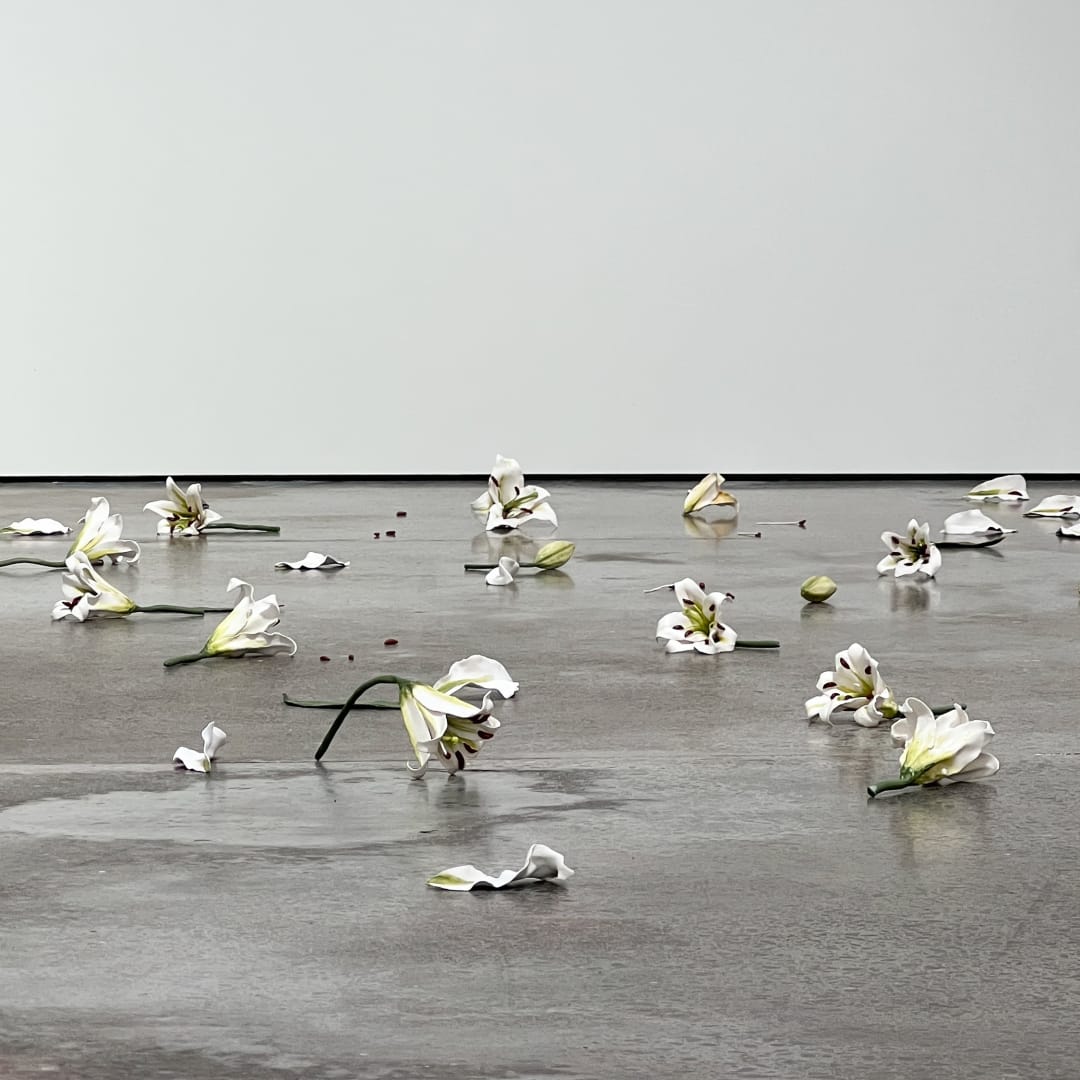Sumer is pleased to present Tracing a gilded trail by Tāmaki Makaurau-based artist Cindy Huang. This is the artist’s first solo exhibition with the gallery.
The exhibition comprises a large multi-component installation: lily flowers, buds, petals, leaves and stamen, that festoon, nay litter, the gallery floor—jettisoned, dismembered, discarded. These are all objects that have been rendered by the artist’s hand in porcelain clay, life-size and painted in true likeness. And with their keen mimicry and scale of numbers, they possess an eerie uncanniness; almost tricking one in to believing that these objects are actual flowers, yet they are too still, too frozen, crystalline.
The installation is coupled with a single large painting, presented in an adjoining room. A sparse painting, a cloud-like ground in dappled shades of whites and soft greys with hints of green and blue, over which the artist has scribed the lines of a poem of her own making. Words that she has chosen to render in a simple serif typeface, as would-be lines in a book. But unlike a book they float, flow and dance across the canvas, not in straight lines but in arcs and waves, swaying up and down; as if affected by a breeze, or rather as one might hear them spoken. The poem, shown above, also doubles as the full title for the accompanying installation.
Lilies, such as those depicted in Huang’s work, grow wild in the area of Round Hill, Murihiku Southland. Round Hill or ‘Long Hilly’ is located between Riverton and Orepuki. It was the southern-most Chinese settlement in the world between the 1870’s through to the early 1900’s. The lilies are found in Port’s Water Race, a route that follows what was once the water race cut through heavy bush by Chinese miners in 1888-89. They are said to have been imported by the miners and were planted throughout the forest. (There is now little trace of this previous Chinese settlement.) The lilies flower once a year, during Christmas and Lunar New Year.
This work, first shown at Te Atamira, Tāhuna Queenstown, was intended to honour the memory of the Chinese who first arrived in Aotearoa; and specifically, to the regions of Ōtākou Otago and Murihiku Southland, during the gold rushes in the latter half of the 19th Century. These where almost exclusively men from rural parts of the Cantonese provinces, Guangdong and Guangxi, in Southern China. Of these men, and the lives they lived, scant historical records remain. What is known is that they were invariably subjected to extreme hardship: hard physical work in unsafe conditions, and exposure to extremes of weather. In addition to this, they were subjected to persistent racial persecution and cruelty from the British colonial establishment and Pākehā settlers alike. Many of them died young, a result of their dangerous work and woeful living conditions. And as they were unable to reside within town limits, most were buried in unmarked graves. Some of their bodies were latter repatriated to China with assistance of Chinese miners and merchants, and local iwi.
Cindy Huang (born 1997, Rotorua) currently lives and works in Tāmaki Makaurau. She holds Bachelor degrees in Fine Arts (Honours) and Arts, Art History and Media Studies, and a Masters degree in Museums and Cultural Heritage. Huang is an interdisciplinary artist whose practice—encompassing installation, painting, performance and social sculpture—explores ideas of exchange, generosity and adjacency. Her research interests focus on the histories of local Chinese migrant communities and the complex relationships that tauiwi, non-indigenous New Zealanders, can and could have as tangata tiriti. In previous works, Huang has highlighted the lack of recorded history and loss of knowledge relating to Chinese here; and specifically, the whanaungatanga and manaakitanga, reciprocity and kinship, between Māori and Chinese migrant communities in Aotearoa.
Recent exhibitions include: All Eyes, George Fraser Gallery, Auckland (2018), The Beaglehole’s Problem, Meanwhile, Wellington (2020), A Footnote on New Zealand History, Corban Estate Arts Centre, Auckland (2021) and Twin Cultivation, Satellites, Auckland (2022), Cindy Huang (solo), Te Atamira, Queenstown (2022), Nova, Sumer, Auckland (2023).
This project was supported with funding from Asia Foundation New Zealand Te Whītau Tūhono and Creative Communities New Zealand.


